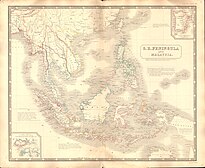Lenggong
It is a rural area, with small kampongs surrounded by green vegetation and limestone hills with numerous caves.
[1] In Malaysia, the earliest remains is a human skull found in the Niah Caves in Sarawak and dates back some 40,000 years.
Excavations at Kota Tampan which began in 1938 revealed an undisturbed stone tool production area.
It is thought that the workshop was disbanded roughly 75,000 years ago due to a volcanic eruption at Lake Toba in Sumatra, approximately 250 kilometres away.
There is a large gap of 17,000 years between Kota Tampan and the next archaeological site, Gua Gunung Runtuh, which has been attributed to the devastating effects of the Toba eruption.
[citation needed] Gua Gunung Runtuh is situated in Bukit Kepala Gajah or Elephant's Head Hill.
The caves were probably used as temporary shelters as seasonal or hunting camps, whereas Gua Gunung Runtuh was lived in for longer periods.
[citation needed] More recently, a team excavated Bukit Jawa, which has been dated at 200,000 years old.
They lived mainly by hunting, evidence shown by the remains of animal bones and molluscs.
The cave was his final resting place situated in Bukit Kepala Gajah or Elephant's Head Hill in the Lenggong Valley of Ulu Perak.
[citation needed] One conclusion that the study made was that he must have been an important member of society because his burial was very elaborate and labour intensive.
[citation needed] In 2004, another skeleton was found at Gua Teluk Kelawar in Lenggong, Perak by a team of Universiti Sains Malaysia (USM) archaeologists.
[citation needed] Lenggong is accessible by trunk roads connecting it with neighbouring towns and cities.
The town of Lenggong is situated some 100 kilometres north of Ipoh on the Kuala Kangsar to Gerik road (highway 76).
